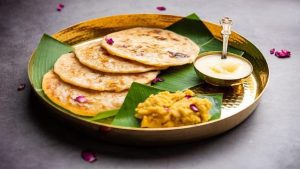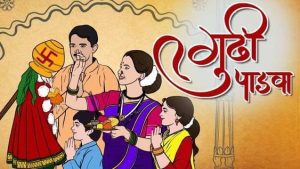Gudi Padwa, the Marathi and Konkani New Year, will be celebrated with great enthusiasm on March 30, 2025. The festival marks the beginning of the Chaitra month in the Hindu lunisolar calendar and is observed as a day of renewal, prosperity, and the triumph of righteousness. In different parts of India, this festival is known by various names, such as Ugadi in Andhra Pradesh, Telangana, and Karnataka, Cheti Chand among Sindhis, and Navreh in Kashmir.
Rich in customs and traditions, Gudi Padwa is an occasion that signifies victory, happiness, and new beginnings. Maharashtrian families commemorate the festival by hoisting the Gudi, performing special rituals, preparing delicious food, and participating in cultural festivities. Let’s explore the significance, rituals, and traditions that make this festival so special.
Significance of Gudi Padwa
Gudi Padwa has deep roots in Hindu mythology. According to legend, Lord Brahma created the universe on this day, marking the beginning of the cycle of time. This belief makes the festival highly auspicious, symbolizing fresh starts, hope, and renewal.
Another important mythological reference is linked to Lord Rama’s victory over Ravana. It is believed that after defeating Ravana, Lord Rama returned to Ayodhya on this day, and people welcomed him by raising Gudis, which later became a tradition.
Historical Relevance
Apart from mythology, the festival also has a strong connection to Maratha history. Chhatrapati Shivaji Maharaj started the tradition of hoisting the Gudi as a symbol of Maratha victories, instilling a sense of pride and unity among his people. Today, Maharashtrians continue this practice to mark success, growth, and positivity in their lives.

Rituals and Traditions of Gudi Padwa
The beauty of Gudi Padwa lies in its age-old customs and traditions, which are followed with devotion. Here are the major rituals associated with the festival:
1. Hoisting the Gudi – The Flag of Victory
The most iconic tradition of Gudi Padwa is hoisting the Gudi outside homes. The Gudi is made using:
- A bamboo stick
- A silk cloth (often saffron or yellow)
- Neem and mango leaves
- A garland of sugar crystals (gathi)
- A silver or copper pot (kalash) placed upside down
The Gudi is considered a symbol of victory and good fortune. It is believed to ward off negativity and bring prosperity to the household. Families raise the Gudi at their windows, balconies, or in front of their doors as a mark of welcoming good luck for the new year.
2. Cleaning and Decorating Homes
Before Gudi Padwa, families thoroughly clean their homes as a way of removing negativity and making space for positive energies. This is similar to Diwali cleaning, emphasizing the importance of fresh beginnings.
To beautify the entrance, women and children create rangoli designs using colored powders, flowers, and rice. The rangoli is meant to attract good luck and happiness into the household.
3. Special Puja and Offerings
Devotees wake up early, take a ceremonial oil bath, and wear new traditional clothes. Women often dress in Nauvari sarees while men wear kurta-pajamas with a saffron turban (pheta).
A special puja is performed to worship the Gudi, along with offerings of flowers, turmeric, and kumkum (vermillion). Devotees pray to Lord Brahma, Lord Vishnu, and Lord Ganesha, seeking blessings for a prosperous year ahead.
4. Eating Neem and Jaggery Prasad
A unique tradition of Gudi Padwa is the consumption of a mixture of:
- Neem leaves (bitter)
- Jaggery (sweet)
- Raw mango (sour)
- Tamarind (tangy)
This combination represents the different flavors of life—joy, sorrow, success, and hardships. It teaches people to accept all experiences with grace. Additionally, neem has medicinal properties, making it beneficial for immunity and digestion.
5. Shobha Yatra – The Grand Procession
On Gudi Padwa, large Shobha Yatras (grand processions) take place in Maharashtra. These parades feature:
- People dressed in traditional Maharashtrian attire
- Women participating in bike rallies wearing Nauvari sarees
- Dhol-tasha (drum) performances
- Lezim dances (a traditional folk dance of Maharashtra)
The processions reflect Maharashtra’s vibrant culture and instill a feeling of unity and pride.


6. Traditional Maharashtrian Delicacies
No Indian festival is complete without mouth-watering food. Gudi Padwa celebrations include the preparation of:
- Puran Poli – A sweet flatbread stuffed with jaggery and lentils
- Shrikhand – A creamy, sweetened yogurt dish flavored with cardamom and saffron
- Poori Bhaji – Deep-fried Indian bread with potato curry
- Sakkar Bhaat – Sweet saffron-flavored rice
Families come together to cook, eat, and share meals, strengthening bonds and spreading happiness.
Regional Variations of Gudi Padwa
While Gudi Padwa is celebrated in Maharashtra, other Indian states observe similar New Year festivals on the same day:
- Ugadi (Andhra Pradesh, Telangana, and Karnataka) – Involves similar rituals and the preparation of Ugadi Pachadi, a six-flavored dish representing life’s different emotions.
- Cheti Chand (Sindhi community) – Marks the birth anniversary of Jhulelal, the patron saint of Sindhis.
- Navreh (Kashmir) – Celebrated by Kashmiri Pandits, honoring Goddess Sharika.


Why Gudi Padwa Matters in Modern Times
In today’s fast-paced world, festivals like Gudi Padwa help preserve cultural heritage and remind people of the importance of:
Family bonding – Coming together to celebrate strengthens relationships.
Gratitude and reflection – A chance to express thankfulness for the past year.
New aspirations – A fresh start for setting goals and ambitions.
Spreading positivity – Encourages optimism and joy in society.
Also Read : Refresh and Revitalize: 5 Best Detox Drinks for a Healthier You
Gudi Padwa 2025 is not just a festival; it is an emotion, a tradition, and a celebration of new beginnings. It reflects Maharashtra’s rich cultural heritage and continues to be observed with enthusiasm, keeping age-old traditions alive.
As the new year begins, let us embrace the values of positivity, gratitude, and renewal, just as Gudi Padwa has symbolized for centuries. May this festival bring prosperity, health, and happiness to all!

